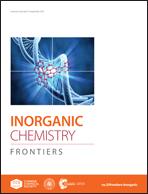Pressure-induced reversible framework rearrangement and increased polarization in the polar [NH4][Cd(HCOO)3] hybrid perovskite†
Abstract
In this work, we study the structural changes of the polar [NH4][Cd(HCOO)3] hybrid perovskite under external hydrostatic pressure. We report a reversible framework rearrangement as a function of pressure characterized by: (i) a gradual modification of one formate ligand, which changes its coordination mode from a bridging syn–anti mode at atmospheric pressure (LP-phase) to a chelating-anti mode at high-pressure (HP-phase) and (ii) a change in the coordination of the Cd2+ cations from six-coordinated (LP-phase) to hepta-coordinated (HP-phase). Very interestingly, this unprecedented framework arrangement displays a large electrical polarization. For instance, the polarization value observed at p = 17.7 GPa is about four times the polarization at atmospheric pressure. Therefore, we report that the external pressure induces a novel framework rearrangement in the polar [NH4][Cd(HCOO)3] hybrid perovskite with enhanced electrical polarization. This structure–property relationship offers new insights for designing novel ferroelectric materials based on pressure-responsive hybrid perovskite materials.
![Graphical abstract: Pressure-induced reversible framework rearrangement and increased polarization in the polar [NH4][Cd(HCOO)3] hybrid perovskite](/en/Image/Get?imageInfo.ImageType=GA&imageInfo.ImageIdentifier.ManuscriptID=C9QI00749K&imageInfo.ImageIdentifier.Year=2019)


 Please wait while we load your content...
Please wait while we load your content...